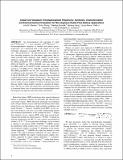| dc.contributor.author | Gvozdik, Nataliya | |
| dc.contributor.author | Stevenson, Keith J. | |
| dc.contributor.author | Stauber, Julia M. | |
| dc.contributor.author | Zhang, Shiyu | |
| dc.contributor.author | Jiang, Yanfeng | |
| dc.contributor.author | Avena, Laura | |
| dc.contributor.author | Cummins, Christopher C | |
| dc.date.accessioned | 2018-12-12T20:43:42Z | |
| dc.date.available | 2018-12-12T20:43:42Z | |
| dc.date.issued | 2018-01 | |
| dc.date.submitted | 2017-08 | |
| dc.identifier.issn | 0002-7863 | |
| dc.identifier.issn | 1520-5126 | |
| dc.identifier.uri | http://hdl.handle.net/1721.1/119623 | |
| dc.description.abstract | An electrochemical cell consisting of cobalt ([Co[superscript II/III](P₃O₉)₂]4⁻/3⁻) and vanadium ([V[superscript III/II](P₃O₉)₂]3⁻/4⁻) bistrimetaphosphate complexes as catholyte and anolyte species, respectively, was constructed with a cell voltage of 2.4 V and Coulombic efficiencies >90% for up to 100 total cycles. The [Co(P₃O₉)₂]4⁻ (1) and [V(P₃O₉)₂]3⁻ (2) complexes have favorable properties for flow-battery applications, including reversible redox chemistry, high stability toward electrochemical cycling, and high solubility in MeCN (1.09 ± 0.02 M, [PPN]₄[1]·2MeCN; 0.77 ± 0.06 M, [PPN]3[2]·DME). The [PPN]₄[1]·2MeCN and [PPN]₃[2]·DME salts were isolated as crystalline solids in 82 and 68% yields, respectively, and characterized by 31P NMR, UV/vis, ESI-MS(−), and IR spectroscopy. The [PPN]₄[1]·2MeCN salt was also structurally characterized, crystallizing in the monoclinic P21/c space group. Treatment of 1 with [(p-BrC₆H₄)₃N]⁺ allowed for isolation of the one-electron-oxidized spin-crossover (SCO) complex, [Co(P3O₉)₂]₃– (3), which is the active catholyte species generated during cell charging. The success of the 1-2 cell provides a promising entry point to a potential future class of transition-metal metaphosphate-based all-inorganic non-aqueous redox-flow battery electrolytes. | en_US |
| dc.language.iso | en_US | |
| dc.publisher | American Chemical Society (ACS) | en_US |
| dc.relation.isversionof | http://dx.doi.org/10.1021/jacs.7b08751 | en_US |
| dc.rights | Article is made available in accordance with the publisher's policy and may be subject to US copyright law. Please refer to the publisher's site for terms of use. | en_US |
| dc.source | Prof. Cummins via Erja Kajosalo | en_US |
| dc.title | Cobalt and Vanadium Trimetaphosphate Polyanions: Synthesis, Characterization, and Electrochemical Evaluation for Non-aqueous Redox-Flow Battery Applications | en_US |
| dc.type | Article | en_US |
| dc.identifier.citation | Stauber, Julia M. et al. “Cobalt and Vanadium Trimetaphosphate Polyanions: Synthesis, Characterization, and Electrochemical Evaluation for Non-Aqueous Redox-Flow Battery Applications.” Journal of the American Chemical Society 140, 2 (January 2018): 538–541 © 2017 American Chemical Society | en_US |
| dc.contributor.department | Massachusetts Institute of Technology. Department of Chemistry | en_US |
| dc.contributor.approver | Cummins, Christopher C. | en_US |
| dc.contributor.mitauthor | Stauber, Julia M. | |
| dc.contributor.mitauthor | Zhang, Shiyu | |
| dc.contributor.mitauthor | Jiang, Yanfeng | |
| dc.contributor.mitauthor | Avena, Laura | |
| dc.contributor.mitauthor | Cummins, Christopher C | |
| dc.relation.journal | Journal of the American Chemical Society | en_US |
| dc.eprint.version | Author's final manuscript | en_US |
| dc.type.uri | http://purl.org/eprint/type/JournalArticle | en_US |
| eprint.status | http://purl.org/eprint/status/PeerReviewed | en_US |
| dspace.orderedauthors | Stauber, Julia M.; Zhang, Shiyu; Gvozdik, Nataliya; Jiang, Yanfeng; Avena, Laura; Stevenson, Keith J.; Cummins, Christopher C. | en_US |
| dspace.embargo.terms | N | en_US |
| dc.identifier.orcid | https://orcid.org/0000-0001-9783-907X | |
| dc.identifier.orcid | https://orcid.org/0000-0003-3497-181X | |
| dc.identifier.orcid | https://orcid.org/0000-0001-9557-0281 | |
| dc.identifier.orcid | https://orcid.org/0000-0003-2568-3269 | |
| mit.license | PUBLISHER_POLICY | en_US |
